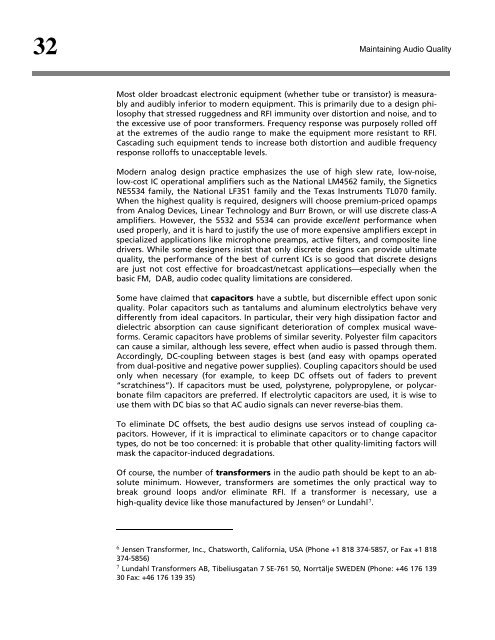Maintaining Audio Quality in the Broadcast Facility 2011 - Orban
Maintaining Audio Quality in the Broadcast Facility 2011 - Orban
Maintaining Audio Quality in the Broadcast Facility 2011 - Orban
Create successful ePaper yourself
Turn your PDF publications into a flip-book with our unique Google optimized e-Paper software.
32<br />
<strong>Ma<strong>in</strong>ta<strong>in</strong><strong>in</strong>g</strong> <strong>Audio</strong> <strong>Quality</strong><br />
Most older broadcast electronic equipment (whe<strong>the</strong>r tube or transistor) is measurably<br />
and audibly <strong>in</strong>ferior to modern equipment. This is primarily due to a design philosophy<br />
that stressed ruggedness and RFI immunity over distortion and noise, and to<br />
<strong>the</strong> excessive use of poor transformers. Frequency response was purposely rolled off<br />
at <strong>the</strong> extremes of <strong>the</strong> audio range to make <strong>the</strong> equipment more resistant to RFI.<br />
Cascad<strong>in</strong>g such equipment tends to <strong>in</strong>crease both distortion and audible frequency<br />
response rolloffs to unacceptable levels.<br />
Modern analog design practice emphasizes <strong>the</strong> use of high slew rate, low-noise,<br />
low-cost IC operational amplifiers such as <strong>the</strong> National LM4562 family, <strong>the</strong> Signetics<br />
NE5534 family, <strong>the</strong> National LF351 family and <strong>the</strong> Texas Instruments TL070 family.<br />
When <strong>the</strong> highest quality is required, designers will choose premium-priced opamps<br />
from Analog Devices, L<strong>in</strong>ear Technology and Burr Brown, or will use discrete class-A<br />
amplifiers. However, <strong>the</strong> 5532 and 5534 can provide excellent performance when<br />
used properly, and it is hard to justify <strong>the</strong> use of more expensive amplifiers except <strong>in</strong><br />
specialized applications like microphone preamps, active filters, and composite l<strong>in</strong>e<br />
drivers. While some designers <strong>in</strong>sist that only discrete designs can provide ultimate<br />
quality, <strong>the</strong> performance of <strong>the</strong> best of current ICs is so good that discrete designs<br />
are just not cost effective for broadcast/netcast applications—especially when <strong>the</strong><br />
basic FM, DAB, audio codec quality limitations are considered.<br />
Some have claimed that capacitors have a subtle, but discernible effect upon sonic<br />
quality. Polar capacitors such as tantalums and alum<strong>in</strong>um electrolytics behave very<br />
differently from ideal capacitors. In particular, <strong>the</strong>ir very high dissipation factor and<br />
dielectric absorption can cause significant deterioration of complex musical waveforms.<br />
Ceramic capacitors have problems of similar severity. Polyester film capacitors<br />
can cause a similar, although less severe, effect when audio is passed through <strong>the</strong>m.<br />
Accord<strong>in</strong>gly, DC-coupl<strong>in</strong>g between stages is best (and easy with opamps operated<br />
from dual-positive and negative power supplies). Coupl<strong>in</strong>g capacitors should be used<br />
only when necessary (for example, to keep DC offsets out of faders to prevent<br />
“scratch<strong>in</strong>ess”). If capacitors must be used, polystyrene, polypropylene, or polycarbonate<br />
film capacitors are preferred. If electrolytic capacitors are used, it is wise to<br />
use <strong>the</strong>m with DC bias so that AC audio signals can never reverse-bias <strong>the</strong>m.<br />
To elim<strong>in</strong>ate DC offsets, <strong>the</strong> best audio designs use servos <strong>in</strong>stead of coupl<strong>in</strong>g capacitors.<br />
However, if it is impractical to elim<strong>in</strong>ate capacitors or to change capacitor<br />
types, do not be too concerned: it is probable that o<strong>the</strong>r quality-limit<strong>in</strong>g factors will<br />
mask <strong>the</strong> capacitor-<strong>in</strong>duced degradations.<br />
Of course, <strong>the</strong> number of transformers <strong>in</strong> <strong>the</strong> audio path should be kept to an absolute<br />
m<strong>in</strong>imum. However, transformers are sometimes <strong>the</strong> only practical way to<br />
break ground loops and/or elim<strong>in</strong>ate RFI. If a transformer is necessary, use a<br />
high-quality device like those manufactured by Jensen 6 or Lundahl 7 .<br />
6 Jensen Transformer, Inc., Chatsworth, California, USA (Phone +1 818 374-5857, or Fax +1 818<br />
374-5856)<br />
7 Lundahl Transformers AB, Tibeliusgatan 7 SE-761 50, Norrtälje SWEDEN (Phone: +46 176 139<br />
30 Fax: +46 176 139 35)



![[PDF] Using the ITU BS.1770-2 and CBS Loudness Meters ... - Orban](https://img.yumpu.com/50629372/1/190x245/pdf-using-the-itu-bs1770-2-and-cbs-loudness-meters-orban.jpg?quality=85)






![[PDF] Optimod-FM Feature Comparison - Orban](https://img.yumpu.com/41741615/1/190x245/pdf-optimod-fm-feature-comparison-orban.jpg?quality=85)






